Lead Pricing
| Interior | Outside | Balcony | Suite |
|---|---|---|---|
| Request Price | Request Price | Request Price | Request Price |

At Aurora Expeditions wilderness is a passion they share with others by taking small groups of like-minded people to some of the most isolated places on our planet. From the polar regions of Antarctica and High Arctic to the wilds of Costa Rica, Scotland, Patagonia and more, Aurora Expeditions aims to create special expedition-style cruises that foster an understanding and appreciation of our natural world.
The Australian-owned adventure company was initially established in the early 1990¹s by adventures Greg Mortimer and Margaret Werner when they began sharing their love of remote places by organising ship-based trips for keen friends and fellow travellers. Their style to push the boundaries¹ has remained unchanged and they are proud of the fact that their spirit of adventure and exploration is as strong as ever. Their adventure activities are proof of this; with many of their voyages offering polar scuba diving, sea kayaking, camping and mountain climbing.
Deeply committed to education and preservation of the environment, Aurora Expeditions were the founding member of both the International Association of Antarctic Tour Operators (IAATO) and the Association of Arctic Expedition Cruise Operators (AECO). All their voyages have expert expedition staff who will help to unlock the wonders of these special places.
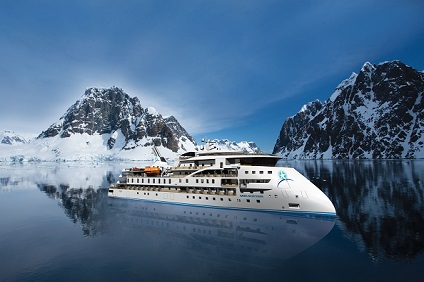
Deck: 3 | Quantity: 15 | Size: 23.2 m2
Cabin Features
Twin or double bed
Private En-suite
Porthole window
Desk area
Closet space
Sofa bed (can sleep 3rd passenger in select cabins)
Room-controlled thermostat
Safe for storing valuables
42″ flat-screen TV
Deck: 3 | Quantity: 15 | Size: 23.2 m2
Cabin Features
Twin or double bed
Private En-suite
Porthole window
Desk area
Closet space
Sofa bed (can sleep 3rd passenger in select cabins)
Room-controlled thermostat
Safe for storing valuables
42″ flat-screen TV
Decks: 4 & 6 | Quantity: 58 | Cabin and balcony combined size: 16.1m2 – 21m2. Cabin Features Twin or double bed Private En-suite Floor to ceiling window Desk area Closet space Private balcony Room-controlled thermostat Safe for storing valuables 42″ flat-screen TV
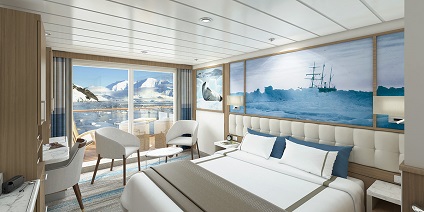
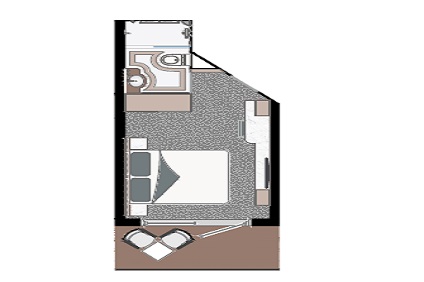
Decks: 4 & 6 | Quantity: 58 | Cabin and balcony combined size: 16.1m2 – 21m2. Cabin Features Twin or double bed Private En-suite Floor to ceiling window Desk area Closet space Private balcony Room-controlled thermostat Safe for storing valuables 42″ flat-screen TV
Decks: 4 & 6 | Quantity: 58 | Cabin and balcony combined size: 16.1m2 – 21m2. Cabin Features
Twin or double bed
Private En-suite
Floor to ceiling window
Desk area
Closet space
Private balcony
Room-controlled thermostat
Safe for storing valuables
42″ flat-screen TV
Deck: 4 | Quantity: 2 | Cabin and balcony combined size: 30.5m2 – 40.2 m2.
Cabin Features
Twin or double bed
Private en-suite
Full size window
Desk area
Closet space
Private balcony
Room-controlled thermostat
Safe for storing valuables
42″ flat-screen TV
Deck: 7 | Quantity: 4 | Cabin and balcony combined size: 38.9 m2. Cabin Features
Twin or double bed
Private en-suite
Full size window
Desk area
Closet space
Private balcony
Room-controlled thermostat
Safe for storing valuables
42″ flat-screen TV
Seperate lounge area
Deck: 4 | Quantity: 1 | Cabin and balcony combined size: 44.5 m2. Cabin Features
Twin or double bed
Private en-suite
Full size window
Desk area
Closet space
Private balcony
Room-controlled thermostat
Safe for storing valuables
Seperate lounge area
42″ flat-screen TV


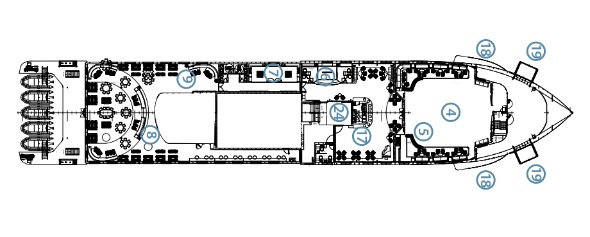

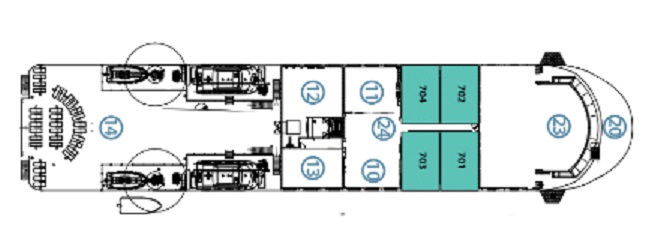
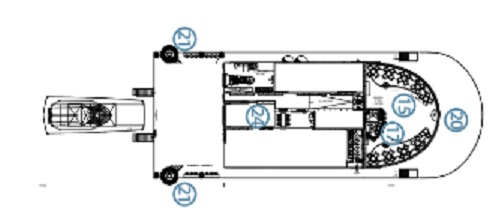
Aurora Expeditions is excited to be launching their new ship, the Greg Mortimer, ready for the Antarctic season in, 2019.
Proudly named after Aurora’s adventurous co-founder, this 104-metre ship is Aurora’s very first, purpose-built expedition vessel. Capable of negotiating the strongest winds and waves, the Greg Mortimer is built to world-class polar standards – designed in close consultation with their expedition specialists, taking advantage of more than 27 years of experience.
Whether it’s adventure, wildlife or simply relaxing that draws you to the planet’s wildest places, the Greg Mortimer will deliver the best expedition cruising experience. The Greg Mortimer will continue to retain Aurora’s ethos and focus on multiple landings, flexible itineraries, environmental sensitivity and family-built atmosphere.
Ship Profile & Stats
- Length: 104 metres
- Tonnage: 7,400
- Maiden Voyage: 2019
- Passenger Capacity (dbl): 160
- Ship Registration: Bahamas
Ship Facilities
- Ship Shop
- Lounge / Lecture Theatre
- Reception
- Change Room / Mudroom
- Zodiac Landing Platforms
- Activity Launching Platform
- Dining Room
- Photography & Art Room
- Library
- Gym
- Sauna / Wellness Centre
- Sun Deck
- Observation Lounge
- Top Deck
- Bars
- Viewing Platforms
- Hydraulic Platforms
- Observation Deck
- Jacuzzis / Plunge Pools
- Medical Centre

Cruise Itinerary
| Date | Activity | Arrive | Depart |
|---|---|---|---|
| 13 May '22 | Dublin, Ireland |
Hotel | |
| 14 May '22 | Dublin, Ireland |
Embark | |
| 15 May '22 | Tory Island, Ireland |
||
| 16 May '22 | Tory Island, Ireland |
||
| 17 May '22 | Sligo, Mullaghmore |
||
| 18 May '22 | Clare Island, Ireland |
||
| 19 May '22 | Connemara, Ireland |
||
| 20 May '22 | Connemara, Ireland |
||
| 21 May '22 | Connemara, Ireland |
||
| 22 May '22 | Connemara, Ireland |
||
| 23 May '22 | Dingle, Ireland |
||
| 24 May '22 | Skellig Rock, Ireland |
||
| 25 May '22 | At sea | ||
| 26 May '22 | Dublin, Ireland |
Disembark |
All itineraries and ports of call at the discretion of the cruise line subject to local weather conditions and may change without notice.
12 Night Cruise sailing from Dublin roundtrip aboard Greg Mortimer. Hotel stay pre-cruise in Dublin.
Day 1 Dublin
Arrive in Dublin and make your way to your hotel. Upon check-in, please remind reception staff to provide you with Aurora Expedition cabin tags. Please fill out the luggage tags clearly, showing your name and cabin number so that we can deliver your luggage to your cabin ahead of your arrival.
Day 2 Dublin, embark Greg Mortimer
This morning, please take your luggage, clearly labelled with your name and cabin number, down to the hotel lobby by 9.00 am. Your luggage will be collected and transferred directly to the port for clearance, and delivered to your cabin. Please ensure you keep any valuable documents with you throughout the day. Once you have checked out of your hotel, you have free time before meeting back in the hotel lobby at 1.00 PM to commence tour of Dublin, UNESCO City of Literature, before embarking the Greg Mortimer in late afternoon. You’ll have time to settle into your cabin before our important briefings. Sail past Giant’s Causeway, an area of about 40,000 interlocking and stacked basalt columns that resulted from an ancient volcanic fissure eruption. The stunning geometric sculptural forms, a national nature reserve, and declared a UNESCO World Heritage Site in 1986, resemble a man-made art installation. From the ship, we may also see the ruins of medieval Dunluce Castle, located on the edge of a basalt outcrop overlooking the Atlantic Ocean.
Day 3 Donegal: Inishowen Peninsula & Tory Island
Ireland is blessed with impressive natural scenery: vast valleys, glittering lakes, and cliffs hoisted up from the Atlantic. The jewel in the crown of Donegal is the Inishowen Peninsula. At the peninsula’s tip is Malin Head, Ireland’s most northerly point and a wonderful spot for bird watching as you meander along abandoned beaches along this deserted coastline.
Continue to Tory Island located off the northwest coast of Donegal. Known simply as ‘Tory’, it’s a place that seems to have frozen in time, ruled by its own elected king, and where people still talk of ‘travelling to Ireland’. Tory’s spectacular cliff scenery is complemented by a rich and varied history which is related in the islanders distinctive Gaelic. Many of Tory’s ancient customs still survive, including the appointment of the island king or Rà ThoraÃ. Colm Cille figures prominently in the history of this sacred island which he chose as a place of retreat and meditation for his monks. Shipwrecks, poitÃn (a type of distilled whisky) smuggling and tales of violent storms have also been drawn into its folklore. Interesting historical sites include a round tower that once protected monks from Viking raids, the ruins of St Colmcille’s 6th century monastery and the intriguing Tau Cross that suggests early seafaring links to the Coptic Christians of Egypt. The island also boasts an abundance of rare bird life and wild flower species. However, it is neither the flora and fauna, myths, the monastic ruins nor even the majestic cliffs which make the greatest impression on visitors to Tory. It is the local islanders themselves, and typical of hardworking people who live in remote, the islanders know how to enjoy themselves and they always make visitors feel extremely welcome.
Day 4 Donegal, Slieve League Cliffs
Slieve League Cliffs, situated on the south west coast of County Donegal, are said to be the one of the highest and finest marine cliffs in Europe. Hike to the top of the cliffs to enjoy some of the highest and finest marine cliffs in Europe. There are terrific views of the Atlantic Ocean, the Sligo Mountains and Donegal Bay as you walk towards the terrifyingly high top of Slieve League, where the cliff face of Bunglas rises over 600 m / 1,968 ft above the raging ocean.
Less experienced hikers can start from the Bunglas Viewpoint, that offer classic views of the cliffs. Most people only follow the first section of this cliff path, built out of stone steps, but within just 15-20 minutes of climbing, you’re in the wild. Follow the cliffs as long as you’d like, until you’re standing at the highest point of the Slieve League cliffs, watching diving sea birds.
More experienced hikers can continue all the way to the Pilgrim’s Path – a 3 km / 1.9 mi hike taking approximately 2-3 hours roundtrip. The Pilgrim’s Path is narrow and steep. Parts of it can be rocky underfoot, and boggy in other places. The trail’s name comes from the time when Ireland’s Penal laws in the 18th and 19th centuries forced Irish Roman Catholic dissenters to convert to the English Anglican Church. This meant that official Catholic worship was outlawed. However, many Catholics refused to convert, and met secretly to say mass in remote, rural places, such as Slieve League.
Day 5 Sligo, Mullaghmore
Jutting out of Sligo’s northern edge, the small peninsula of Mullaghmore sits dramatically out into the North Atlantic. Land and sea meet in dramatic confluence along the coast of County Sligo, a dazzling landscape of jagged mountain peaks that inspired the work of Nobel-winning poet William Butler Yeats. Mullaghmore resides in the shadows of iconic Benbulben mountain, undoubtedly Ireland’s most distinctive mountain, sometimes referred to as Ireland’s own Table Mountain. The most distinctive peak among the Dartry range, it was formed during the ice age by massive glaciers segmenting the landscape.
On the Benbulben Forest Walk (1.5 hours, suitable for all ages and abilities), the trail begins in a secluded forest area before opening out to stunning views of Benbulben head. Further along the walk offers superb panoramic views of Donegal Bay, Slieve League Cliffs, Mullaghmore and Classiebawn Castle. And, of course, Yeats himself is buried “Under bare Ben Bulben’s head,”, as he predicted in one of his poems – his grave can be found in Drumcliff cemetery, not far from the foot of the mountain. The mountain’s most noted reference in Yeats’s poetry is in the work Under Ben Bulben, in which he describes horsemen who “ride the wintry dawn/Where Ben Bulben sets the scene”.
Alternatively, embark on the Mullaghmore Head Walk (2.5 hours, suitable for all ages and abilities). This walk is an easy walk along the stunning coastline of Mullaghmore consisting of a mixture of footpaths, off-road walking trails and public roads, offering stunning panoramic views of Donegal Bay and Slieve League beyond as well as of Benbulben and the Dartry Mountains.
Mullaghmore village, is largely the vision of Henry John Temple, better known as Lord Palmerston, who served two terms in office as British Prime Minister. He inherited a large estate of 10,000 acres in north Sligo, and not only instigated the building of Classiebawn Castle, the dominant landmark of the area, but also the magnificent stone harbour and the main buildings that characterise the village today.
After your morning of hiking, return to the ship for lunch. In the afternoon, land on one of the offshore islands to see a protected wildlife sanctuary and a 6th century monastery, where the discovery of a cist burial and carved ‘cursing’ stones suggests prehistoric occupation.
Day 6 Céide Fields / Clare Island
Ireland’s Stone Age ancestors constructed houses, walls and fields that created an early farming community complete with megalithic tombs. One of these communities was Céide Fields, which contains the oldest known stone-walled fields in the world – dating back nearly 6,000 years. Céide Fields overlooks the mighty Atlantic Ocean pounding against the cliffs below. The landscape itself has been forged from the dramatic upheaval and movement of the earth’s crust over millions of years.
Visit the remarkable Céide Fields Interpretative Centre. The centre has won several awards, including the Gold Medal for architecture. It is located beside some of the most spectacular cliffs and rock formations in Ireland and a viewing platform is positioned on the edge of the 110m high cliff. One of the exhibits that confronts visitors upon entering the centre is a 4,000-year-old pine tree that was unearthed from nearby bog land.
Clare Island
Clare Island is a mountainous island guarding the entrance to Clew Bay in County Mayo. It is famous as the home of the pirate queen Grace O’Malley (Granuaile), who was known as a tyrant of the ocean, clan chieftain, mother, wife, survivor and brilliant politician. Although her deeds relatively unknown outside of Ireland, the legacy of her mastery survives in the ruined monuments and the folk-consciousness on Clare Island and Ireland.
Clare is the largest and highest of Clew Bay’s many islands, with dramatic coastal cliffs and spectacular views of one of Ireland’s best-known peaks, Croagh Patrick. Its spectacular cliffs are home to large numbers of nesting sea birds and its hills, bogs and woodlands make it ideal for hill walking, with a variety of walks and climbs to suit all fitness and interest levels including: Archaeological Trail, Fawnglass Loop and Knocknaveena Loop.
Days 7-10 Connemara
Dubbed a place of “savage beauty” by Oscar Wilde the Connemara lets you experience authentic Ireland. On coastal hills walks take in views of soaring mountains, clear turquoise waters and rare flora and fauna.
Killary Harbour, carved by glaciers, it’s been described as Ireland´s only true fjord. It forms the border between Galway and Mayo counties and features some of the most spectacular scenery on the west coast. This deep-water inlet from the Atlantic was once a hiding place for U-boats in World War Two. The sheltered fjord is also a real treat for birdwatching, with nationally important populations of many species, including ringed plover, mute swan, whooper swan, mallard duck, tufted duck, and barnacle goose. Dolphins are often seen in the fjord, along with otters, a protected species that are known to breed at Killary Harbour.
Breathtaking mountain vistas provide a dramatic backdrop for Leenane, a town nestled beside the water at the head of the fjord. In 1903, Leenane played host to King Edward VIII and Queen Alexandra when they made a tour of Connemara including a visit to nearby Kylemore. Visit the Sheep and Wool Centre in the town centre that includes an excellent museum featuring the history of sheep farming and the woollen industry in Connemara, along with a gift shop and café.
Connemara is Irish landscape at its most dramatic. With soaring mountains, scattered loughs and an intricate coastline, this remote part of Galway offers superb hiking. Stretch out your legs on the Killary Harbour Coastal Walk, also known as the ‘Famine Trail’, where you’ll walk past little cottages that faced extremely gruelling times during the 1840s. In recent times, Killary Harbour has become a centre for aquaculture, with mussels being farmed in the deep, clear waters of the fjord. Fish cages belonging to a salmon farm and mussel rafts are a prominent feature. This spectacular walk offers views of dramatic Mweelrea Mountain towering at your side.
Day 11 Dingle Peninsula
There are over 2,500 archaeological sites on the Dingle Peninsula, spanning a period from 6,000 BC through to 1700 AD. The area is regarded as having one of the richest concentrations of archaeological monuments in Western Europe. National Geographic once described it as “the most beautiful place on earthâ€, and more recently, one of the locations where Star Wars was filmed, at Sybil Head.
We enjoy a ship cruise at Great Blasket Island, and perhaps launch our Zodiacs allowing us to get closer to the cliffs to perhaps get a glimpse of the huge number of breeding seabirds such as puffins, fulmars, guillemots, storm petrels and shearwaters. In the water, you may be lucky and encounter dolphins, whales, orcas and porpoise.
After lunch, we anchor at Dingle and embark on a guided tour of some of Dingle Peninsula’s ancient sites. The tour travels west of Dingle Town on the Slea Head route, considered one of the most scenic landscapes in Europe. Among the sites visited are Ogham stones, monastic sites, beehive huts, ringforts, medieval churches, holy wells, Gallarus oratory.
Afterwards, visit the renowned Dingle Distillery for a tour of their facility where you can learn about the production process of their gin and vodka as well as enjoy a tasting. The distillery is not in the business of creating megabrands, nor do they distil for anyone else. Their scale is modest, their approach to what they make is essentially artisan and they have rekindled the tradition of independent distilling in Ireland. Two hundred years ago, this small island had over a hundred officially recognised distilleries; by the turn of this century there were two. Their unique Dingle Whiskey continually matures in the mild, moist climate of Ireland’s south-west coast while those first spirits are bottled into a magnificent single malt whiskey. You can also enjoy the fruits of their labours in the form of Dingle Original Gin and Dingle Distillery Vodka.
Day 12 The Skelligs
Off the coast of County Kerry, two rocky pinnacles rise from the Atlantic Ocean. These spectacularly Skellig Islands are world-renowned for their ornithological and archaeological significance. Skellig Michael is known throughout the world of archaeology as the site of a well-preserved monastic outpost of the Early Christian period – now designated a UNESCO World Heritage Site; Little Skellig (Irish: Sceilg Mhichil) is equally renowned in matters of ornithology as the home of roughly 27,000 pairs of gannets – the second largest colony of such seabirds in the world. Enjoy a ship cruise around Little Skellig (Irish: Sceilg Mhichil) to get a glimpse of the incredible gannet colony on the island. Afterwards, we dock at Portmagee, and with the blessing of fine weather, we plan to visit and land on Skellig Michael.
Approximately 1,400 years ago a small group of men were searching for a place to practice their religion in complete solitude and isolation. These remarkable men ventured into the open ocean off southwest Ireland determined to build a monastery on one of the most extraordinarily remote locations on earth. Generation after generation of monks helped to hand-carve the 600 stone step with the simplest tools, to build a hilltop monastery 200 m / 656 ft above the pounding waves. The monastery has six corbel stone beehive huts and two boat-shaped oratories. The survival of the terraces and drystone walls to this day are testament to the skill and dedication of the monks. The monastery is inscribed as a UNESCO World Heritage Site, a striking example of Early Christian architecture. The archaeological remains show the dramatically spartan conditions in which the monks lived, and after enduring several Viking raids, the monks eventually left the island in the 13th century. The site has subsequently become a place of Christian pilgrimage.
After lunch and a rest, disembark at Castletown-Bearhaven for late-afternoon hikes at Beara Peninsula. On the Bullig Bay Loop Walk (4 km / 2.5 mi – one hour), starting near the ruin of Dunboy castle – seat of the O’Sullivan Bear clan who ruled the Beara Peninsula for 600 years, the walk offers a pleasant mix of farmland, quiet country road & forest tracks, and wonderful views of Bullig bay and Bear Island. If you’re after a shorter walk, nearby Dinish Island, offers a 15-minute walk around the Island.
Day 13 At Sea
As we come to the end of the voyage, you may choose to enjoy final talks and presentations from our team of experts, edit and organise your photographs or reminisce over a few drinks with fellow travellers and expedition team on a remarkable voyage.
Day 14 Disembark
During the early morning, we cruise into Dublin port, where you disembark at approximately 8.00 am.
